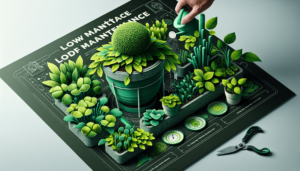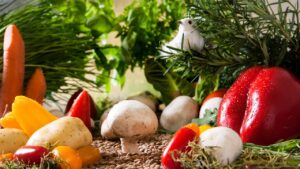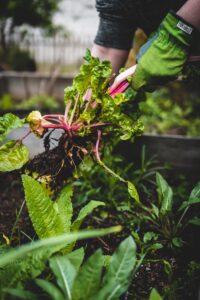So, you’ve decided to start your very own vegetable garden – kudos to you! But hold on, before you start planting those seeds, have you thought about what kind of fertilizer your garden needs? It’s a crucial decision that can make or break the success of your precious plants. Don’t worry; we’ve got your back. In this article, we’ll explore the world of fertilizers and help you navigate the plethora of options to choose the ideal one for your vegetable garden. Get ready to give your plants the boost they need to thrive!
Understanding the Nutritional Needs of Vegetable Plants
Understanding your plants’ nutritional needs is crucial to growing a successful vegetable garden. Like humans, plants require a balanced diet to thrive and produce abundant yields. By providing the proper nutrients, you can ensure your vegetable plants have the best chance of reaching their full potential.
The importance of providing proper nutrients
Proper nutrition is essential for the overall health and vigor of vegetable plants. A lack of nutrients can lead to stunted growth, low yields, and increased susceptibility to pests and diseases. On the other hand, providing the right balance of nutrients can promote robust growth, strong root development, and an abundance of healthy fruits and vegetables.
Essential nutrients for vegetable plants
Veggie plants need several essential nutrients to grow and thrive. These include macronutrients such as nitrogen (N), phosphorus (P), and potassium (K), as well as secondary nutrients like calcium, magnesium, and sulfur. Additionally, micronutrients such as iron, manganese, and zinc are required in smaller quantities but are equally crucial for the overall health of the plants.
Recognizing nutrient deficiencies
Nutrient deficiencies can manifest in various ways, and it’s crucial to recognize the signs to address the issue promptly. Yellowing leaves, stunted growth, and poor fruit development are common indicators of nutrient deficiencies. Learning to identify these signs can help diagnose and treat the problem effectively.
Different Types of Fertilizers
Now that we understand the nutritional needs of vegetable plants, let’s explore the different fertilizers available to fulfill those needs.
Organic fertilizers
Organic fertilizers are derived from natural sources such as compost, manure, and plant materials. They are rich in organic matter and slowly release nutrients into the soil, providing a sustainable and eco-friendly option for vegetable gardeners. Organic fertilizers nourish the plants, improve soil structure, and promote beneficial microbial activity.
Inorganic fertilizers
Inorganic fertilizers, synthetic or chemical fertilizers, are manufactured through industrial processes. They are formulated to provide specific nutrient ratios and are readily available for plant uptake. Inorganic fertilizers offer a quick and targeted solution for nutrient deficiencies but can also harm soil health and the environment if misused.
Slow-release fertilizers
As the name suggests, slow-release fertilizers release nutrients gradually over an extended period. These fertilizers are beneficial for providing a steady supply of nutrients to vegetable plants without the risk of overfertilization or nutrient leaching. Slow-release fertilizers are available in organic and inorganic forms, offering gardeners a convenient option that suits their preferences.
Considerations for Organic Gardeners
For those who prefer an organic approach to gardening, several factors must be considered when choosing fertilizers.
Advantages of using organic fertilizers
Organic fertilizers offer numerous advantages for organic gardeners. They promote soil health and biodiversity, improve water retention, and provide a sustainable method of feeding plants. Organic fertilizers also minimize the risk of fertilizer burn and are generally safer for the environment.
Natural sources of organic fertilizers
A wide range of natural sources can be utilized as organic fertilizers. Compost, made from decomposed organic matter, is an excellent all-around fertilizer that improves soil structure and fertility. Manure from herbivores, such as cows or horses, is another popular organic fertilizer high in essential nutrients. Other options include bone meal, blood meal, and fish emulsion.
Composting and making homemade organic fertilizers
Composting is a cost-effective and sustainable way to create your organic fertilizer. By collecting kitchen scraps, yard waste, and other organic materials, you can create nutrient-rich compost for your vegetable garden. Additionally, homemade fertilizers like compost tea or plant-based liquid fertilizers can be made by steeping organic matter in water and utilizing the resulting liquid as a nutrient boost for your plants.
Understanding Fertilizer Labels
When selecting fertilizers, it’s essential to understand the information provided on fertilizer labels. This will help you make an informed decision and choose the most suitable product for your vegetable garden.
NPK ratio and its significance
The NPK ratio, listed prominently on fertilizer labels, represents the percentage by weight of the three primary macronutrients: nitrogen (N), phosphorus (P), and potassium (K). This ratio indicates the relative abundance of each nutrient in the fertilizer. For example, a fertilizer with an NPK ratio of 10-10-10 contains 10% nitrogen, 10% phosphorus, and 10% potassium. Understanding the NPK ratio is crucial for addressing specific nutrient deficiencies and ensuring the balanced nutrition of your plants.
Other nutrients and additives
Fertilizer labels also provide information about secondary nutrients, micronutrients, and any additional additives present in the product. Secondary nutrients like calcium, magnesium, and sulfur are necessary for optimal plant growth, while micronutrients play a vital role in various biochemical processes. Some fertilizers may include additives such as seaweed extract or beneficial microbes, which can enhance plant growth and provide other beneficial effects.
Different forms of fertilizers (granular, liquid, etc.)
Fertilizers are available in various forms, including granular, liquid, and soluble options. Granular fertilizers are solid pellets or prills applied to the soil surface and slowly release nutrients over time. Liquid fertilizers are mixed with water and applied directly to the soil or foliage, allowing for more immediate nutrient availability. Soluble fertilizers, usually in powder or crystal form, dissolve in water and can be applied via irrigation systems or as foliar sprays.
Matching Fertilizer to Soil Type
Understanding your soil type and specific needs is crucial for selecting the right fertilizer.
Determining your soil type
There are three main soil types: sandy, loamy, and clayey. Sandy soil drains quickly but may lack nutrients, while clayey soil retains water but can become compacted—loamy soil, considered ideal for gardening, balances sand, silt, and clay. Performing a simple soil test or consulting with local agricultural extension services can help you determine your soil type.
Amending soil with appropriate fertilizers
Once you’ve determined your soil type, you can choose fertilizers tailored to its specific needs. Sandy soils benefit from organic matter amendments to improve water and nutrient retention. Clayey soils, on the other hand, may require amendments that will enhance drainage and prevent compaction. Loamy soils generally have good nutrient-holding capacity but may still benefit from periodic applications of balanced fertilizers.
Considering pH levels
pH levels also play a crucial role in nutrient availability. The pH scale ranges from acidic (below 7), neutral (pH 7), to alkaline (above 7). Different vegetables have varying pH preferences, and maintaining optimal pH levels can enhance nutrient uptake. Lime or sulfur amendments can be used to adjust pH, ensuring that the nutrients present in the soil are in a form that plants can easily absorb.
Considering Environmental Factors
Environmental factors, such as climate and weather conditions, can impact the effectiveness of fertilizers and the overall health of your vegetable garden.
Impact of climate and weather
Your growing region’s climate can influence your plants’ nutrient requirements. For example, areas with heavy rainfall have a higher risk of nutrient leaching, requiring more frequent fertilization. On the other hand, arid climates may necessitate using fertilizers that promote water retention, preventing excessive evaporation and ensuring efficient nutrient uptake.
Choosing fertilizers that promote water retention
Water retention is crucial for plant health, as it ensures a continuous supply of nutrients. Choosing fertilizers with additives like organic matter or water-absorbing polymers can improve water retention in the soil. These amendments help prevent moisture stress and reduce irrigation frequency, especially during hot and dry periods.
Minimizing runoff and environmental pollution
Excessive fertilizer use or improper application techniques can lead to runoff, causing environmental pollution in nearby water bodies. To minimize runoff, apply fertilizers only as needed and at the recommended rates. Avoid using fertilizers before heavy rainfall or when the ground is saturated, as these conditions increase the risk of nutrient runoff. Proper timing and application methods can help ensure that nutrients are utilized by your plants while minimizing their impact on the environment.
Understanding Application Methods
Applying fertilizers correctly is essential to maximize their effectiveness and prevent potential harm to your vegetable plants.
Broadcasting vs. banding
Broadcasting involves spreading fertilizer evenly over the soil surface, covering a larger area. This method is suitable for incorporating fertilizers into the top layer of soil or targeting a wide range of plants. Banding, on the other hand, involves placing fertilizer in a narrow strip along the plant rows. This technique allows for targeted nutrient delivery to the plant roots and is especially useful for row crops.
Topdressing vs. incorporation
Topdressing refers to applying fertilizers on the soil surface around established plants. This method is commonly used during the growing season to provide supplemental nutrients. Incorporation, on the other hand, involves mixing fertilizers into the soil before planting. This technique ensures that nutrients are readily available to the plants as their roots grow and develop.
Foliar feeding
Foliar feeding involves applying liquid fertilizers directly to plants’ leaves. This method allows for the efficient absorption of nutrients through the foliage and can quickly boost nutrients to plants experiencing deficiencies. Foliar feeding is beneficial when quick results are desired or when environmental factors or soil conditions may hinder nutrient uptake through the roots.
Timing and Frequency of Fertilizer Application
Knowing when and how often to apply fertilizers is essential for maintaining the health and productivity of your vegetable garden.
Applying pre-planting
Before planting, it is beneficial to incorporate well-balanced fertilizers into the soil to provide a nutritional foundation for your vegetable plants. This ensures that the essential nutrients are readily available to support early growth and development.
Side dressing during the growing season
Your vegetable plants will benefit from additional nutrient supplementation to support their continued growth and fruit production. Side dressing, or fertilizers alongside the plant rows, is standard during the growing season. This helps meet the increasing nutrient demands of the plants as they mature.
Avoiding overfertilization
While providing adequate nutrients is essential, it’s crucial to avoid overfertilization. Excessive fertilizer application can lead to nutrient imbalances, nutrient leaching, and even plant damage. Following the recommended application rates and frequency specified on fertilizer labels and actively monitoring your plants’ health will help prevent overfertilization and ensure optimal growth.
Evaluating Cost and Availability
When choosing the ideal fertilizer for your vegetable garden, consider factors such as cost and availability.
Comparing product prices
Fertilizer prices vary significantly depending on the brand, type, and nutrient content. Comparing prices between different products, both online and in local stores, can help you make an informed decision while staying within your budget. Consider purchasing in larger quantities, as bulk options often provide cost savings.
Evaluating long-term costs
While upfront costs are significant, assessing the long-term costs associated with fertilizers is also essential. Some fertilizers may require more frequent applications, while others offer slow-release properties that reduce the need for frequent reapplication. Considering the nutrient content, release rates, and longevity of different fertilizers can help you choose an option that provides the best value for your investment.
Availability of preferred fertilizers
Lastly, it’s essential to consider the availability of preferred fertilizers in your area. Some fertilizers may be more readily accessible in certain regions, while others may be harder to find. Researching local stores, nurseries, and online sources can help you determine the availability of fertilizers that align with your gardening goals.
Consulting Experts and Local Resources
When selecting the best fertilizer for your vegetable garden, seeking expert guidance and utilizing local resources can be beneficial.
Seeking guidance from agricultural extension services
Agricultural extension services are valuable sources of information for gardeners. They guide soil testing and nutrient recommendations and offer advice specific to your region. Consulting with agricultural extension agents can help you make informed decisions about fertilizers and address any particular challenges or concerns you may have.
Engaging with local gardening communities
Engaging with local gardening communities, in-person or online, can provide valuable insights and firsthand experiences. Gardening clubs, forums, and social media groups offer a platform to connect with fellow gardeners who may have recommendations on fertilizers that have worked well in your area. Sharing experiences and learning from others can help you make more informed fertilizer choices.
Researching reputable sources for recommendations
Numerous reputable sources, such as gardening books and websites, provide comprehensive information on fertilizers. When conducting research, ensure that you refer to reliable sources to obtain accurate and trusted recommendations. University agricultural publications, government agricultural departments, and well-established gardening organizations are often reliable sources of information.
By understanding the nutritional needs of your vegetable plants, exploring different types of fertilizers, considering organic options, deciphering fertilizer labels, matching fertilizers to your soil type, accounting for environmental factors, understanding application methods, timing and frequency of application, evaluating cost and availability, and consulting experts and local resources, you will be well-equipped to choose the ideal fertilizer for your vegetable garden. Remember, a well-nourished garden is thriving, and the right fertilizer can make all the difference in achieving bountiful harvests of healthy and delicious vegetables.



